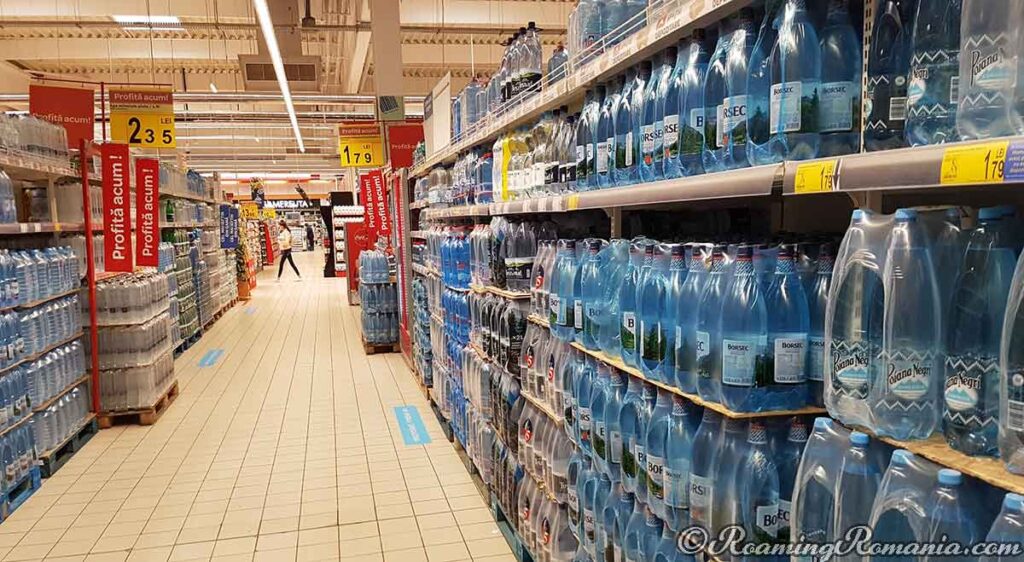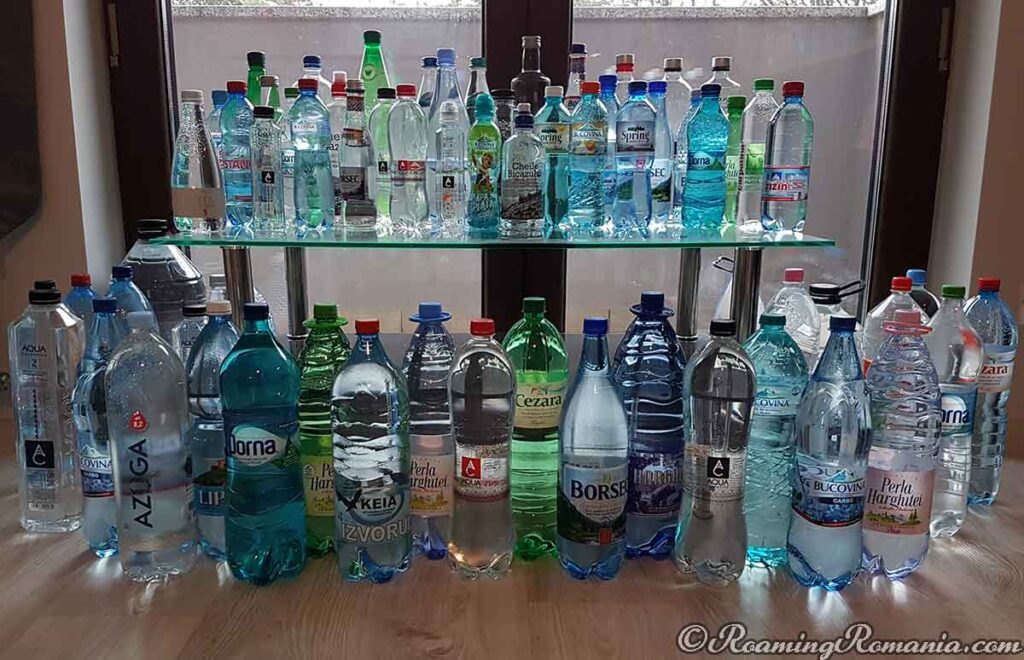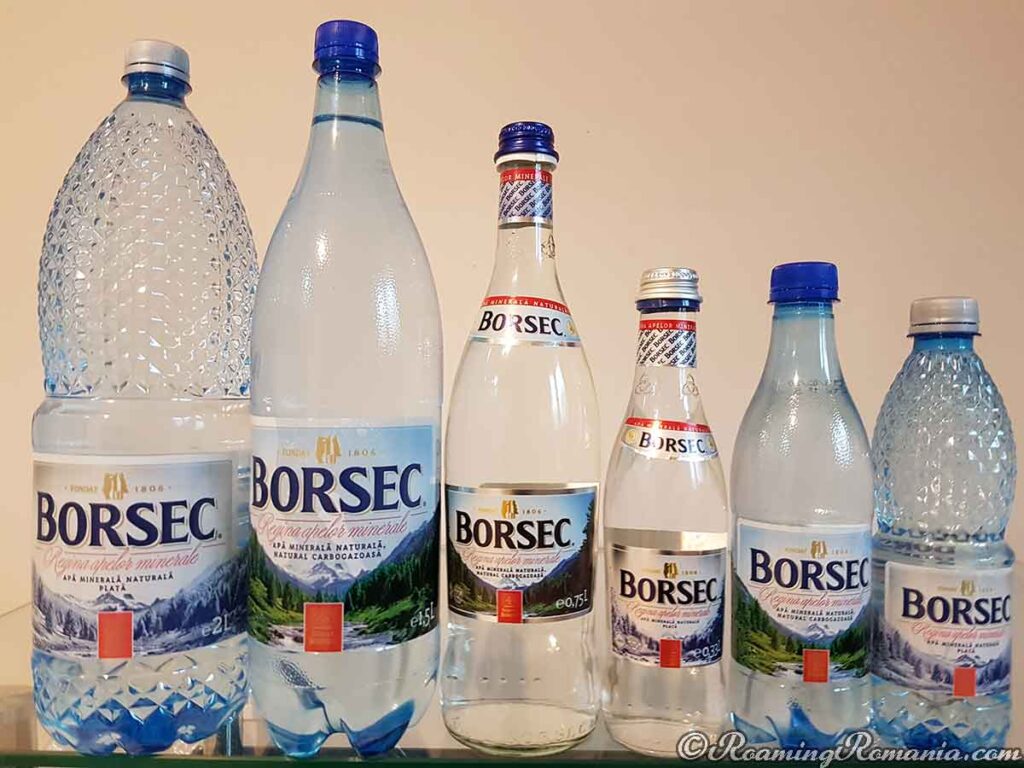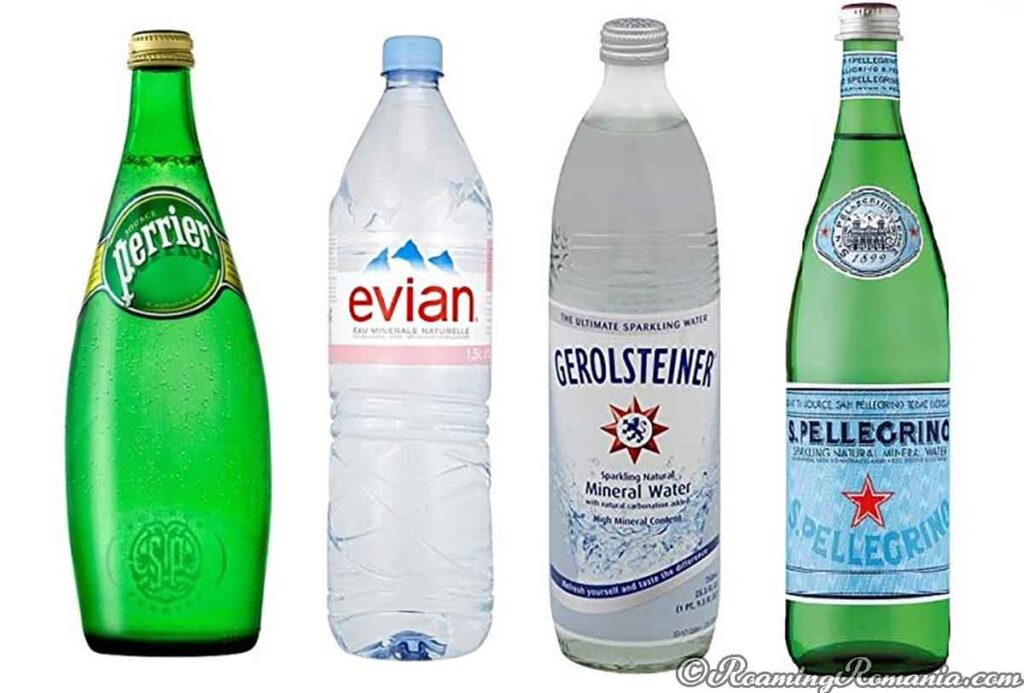After moving to Romania from the United States, one of the first things to stand out to me was the fact that the vast majority of water sold in the country is mineral water. I noticed that mineral water in Romania is cheap, available everywhere, comes in a variety of bottle types, and is sold under a multitude of brands.
Being the “curious about everything Romania” person that I am, I decided to dive deep into researching what is going on with mineral water in Romania. My journey uncovered some amazing, and even startling, discoveries about the phenomenon of naturally occurring Romanian mineral water. And now I’m going to share all that information with you.
But first, before I get into all the astonishing facts about Romania’s mineral water, I’m going to inform you in great detail everything there is to know about mineral water itself. This is going to be a long read and part 1 of a 2-part series, so grab yourself a Borsec, pop the cap, take a sip, and let’s begin the journey.
Table of Contents
- What is Mineral Water
- How is Mineral Water Made
- Difference Between Still and Sparkling
- What Does Mineral Water Taste Like
- What is not Considered Mineral Water
- Is Mineral Water Regulated
- Can Mineral Water be Treated
- What Minerals does Mineral Water Contain
- Is Mineral Water Healthy for You
- Most Popular Brands of Mineral Water
What is Mineral Water?
Mineral water is water that comes from an underground water source such as a well, spring, or aquifer, and contains naturally occurring minerals and trace elements. Mineral water must be bottled at the source in conditions that guarantee the original microbiological purity and chemical composition of essential components.
Official mineral water classifications can vary from country to country, however, most mineral waters across the world typically meet a certain set of common criteria. Water that is designated as natural mineral water usually has to meet all or most of the below checklist.
- Rigorously tested
- Bottled at the source
- Naturally contains minerals
- Untreated (with a few exceptions)
- Regulated nationally or internationally
- Located in deep subterranean reservoirs
- May not contain any chemicals, added minerals, or other types of water
How is Mineral Water Made?
Mineral water is essentially rainwater which has been filtered and mineralized by layers of rock during its process of soaking deep into the ground. The composition, type, volume, and variety of minerals found in mineral water is dependent on three main factors.
- The passage, or lack of passage, through ancient ocean salt beds.
- The types of rocks the water passed through on its underground journey.
- The existence, or non-existence, of naturally present underground carbonic acid.
Different types of rocks located at different depths of the earth contain different types of mineral compositions. Mineral waters which have the biggest variety of minerals are the ones which have passed through the biggest variety of underground rocks.
Some examples of underground rock types which produce mineral waters.
- Dolomite, contains calcium and magnesium
- Limestone, contains calcium and adds bicarbonate
Another factor that affects the composition of mineral water is if the water passed through underground salt deposits left over from primordial oceans. When water passes through these types of salt deposits it gets enriched with chloride and sodium.
Carbonic Acid Effects on Mineral Water Production
The volume (amount) of a particular mineral found inside a mineral water brand is mainly determined by the existence or non-existence of naturally occurring carbonic acid at the mineral water’s source.
Carbonic acid is formed when carbon dioxide (CO2) rises from volcanic magma of the earth’s mantle and mixes with the underground water. Volcanic regions where magma is closest to the earth’s surface produce the highest concentrations of carbonic acid in water.
Carbonic acid is also the natural carbonation that causes “sparkaling” mineral water to fizz when opened. Besides providing the bubbles to the mineral water, the carbonic acid also plays a major role in dissolving valuable minerals off of underground rock deposits.
It’s precisely the extra mineral dissolving where carbonic acid is present that causes some mineral waters to have much higher volumes of minerals compared to others that lack the acid.
What’s the Difference Between Still and Sparkling?
Most mineral water brands on the market come in two different varieties, still, or sparkling. Both variations have to meet the exact same stringent mineral water regulations. The main difference between the two is the presence or absence of effervescence, the bubbles caused by carbon dioxide (C02) carbonation.
The other differences between the two varieties are the concentration of minerals, the taste, and the source where the water originates. Many mineral water brands have multiple springs where they extract water from. The springs that have C02 produce carbonated water, the ones that lack it produce still water.
Natural mineral waters have to contain one of five different descriptions on their labels to inform consumers about the water’s properties. The descriptions are as follows.
- Naturally carbonated natural mineral water;
- Natural mineral water fortified with carbon dioxide from the source;
- Carbonated natural mineral water;
- Non-carbonated natural mineral water;
- Decarbonated natural mineral water.
Carbonated Mineral Water
Carbonated mineral water, also referred to as sparkling mineral water, is water that contains carbon dioxide. Carbon dioxide present in water becomes carbonic acid, a weak acid which acts like a gas. Carbonic acid forms when C02 (carbon dioxide) mixes with H20 (water). Carbonated natural mineral water gets its carbonation through one of three possible ways.
- Naturally carbonated, carbonated naturally by volcanic gasses that produce carbonic acid.
- Fortified carbonation, natural carbon dioxide from the same spring is reintroduced into the water.
- Artificially carbonated, carbon dioxide is added from other sources following strict guidelines.
Naturally carbonated natural mineral water
Naturally carbonated mineral waters come from regions which have had strong volcanic activity in the past. Usually the more volcanic activity at the source of a spring, the higher the concentration of carbonic acid is present in the water. Carbonic acid measurements are done in either grams per liter (g/l) or milligrams per liter (mg/l).
Mineral waters with natural carbonic acid usually contain a much higher concentration of minerals than their counterparts. Carbonic acid plays a key role in dissolving minerals off of rock beds and permeating them into the water. The acid also serves as a natural preservative for the minerals.
Natural mineral water fortified with carbon dioxide from the source
Carbon dioxide fortified natural mineral water is mineral water that originally contained natural carbon dioxide which was temporarily removed and then later reintroduced. Carbon dioxide is often removed from mineral water in order to treat the water by natural processes of removing unstable constituents.
When the original carbon dioxide that was temporarily removed is reintroduced back into the water at different quantities than what the water contained at its emergence the water is considered to be fortified with carbon dioxide. Fortified carbon dioxide waters must be reintroduced with C02 from the original source.
Carbonated natural mineral water
When mineral water without the presence of carbon dioxide is extracted it’s considered a still mineral water. Carbonated natural mineral water is mineral water that was extracted from a still mineral water spring and was later artificially introduced with carbon dioxide.
Mineral water brands are allowed to add C02 originating from various sources to mineral water in order to transform flat water to sparkling. However, mineral water that was carbonated with C02 originating from places other than the water’s source has to be labeled as “carbonated natural mineral water.”
Still Mineral Water
Still, also known as “flat”, natural mineral waters are waters that contain very slight and unnoticeable, or zero, amounts of carbon dioxide.
The trace amounts of carbon dioxide in still mineral water are unnoticeable and are present in order to keep the hydrogen carbonate salts present in the water dissolved. Still mineral water types come in one of two different variations.
- Non-carbonated natural mineral water, originates from its source without any CO2
- Decarbonated natural mineral water, originates with CO2 but had the CO2 removed
What Does Mineral Water Taste Like?
In general, mineral water has a smooth, crisp, refreshing and quenching taste to it. However, there is no umbrella term to describe the taste of all mineral waters since no two mineral waters taste the same. The taste of mineral water is affected by many different variables that work hand-in-hand to provide each water with its uniqueness.
The mineral waters with the most distinctive tastes are usually the ones that have disproportionate amounts of certain minerals. For example, mineral water with excess carbonic acid and limited amounts of minerals taste sour, sulphate rich mineral water is usually bitter, and sodium chloride heavy water tastes salty.
Mineral waters that taste the best are usually mineral waters that have a well-rounded, and proportionate amount of minerals that work together in harmony to provide a balanced, smooth, and crisp taste.
The main factors that affect the taste of mineral water:
- The region and depth it came from
- It’s mineral composition and volumes
- The amount of time it spent underground
- The presence or absence of natural CO2 gases
- The amount and types of rock beds it passed through
What is not Considered Mineral Water?
There are many different types of waters found on store shelves which are often erroneously called mineral water by uninformed consumers. These “imitation” mineral waters usually have similar characteristics (usually artificially added) to real mineral water but are not regulated the same, or allowed to be sold, as real mineral water.
Imitation mineral water is typically filtered spring or tap water that has had artificial effervescence (bubbles) added to it. Some waters are advertised as “vitamin waters.” The vitamins found in these waters don’t occur naturally and are usually added by manufacturers as a marketing ploy.
Below is a list of some of the names of carbonated waters which are often inaccurately confused with mineral water.
- Soda Water
- Tonic Water
- Seltzer Water
- Sparkling Water
Is Mineral Water Regulated?
Mineral water is a highly regulated industry no matter where in the world it’s produced. Although most countries have their own set of regulation criteria, most of the worlds mineral waters adhere to a global standard of regulation.
In the United States, the U.S. Food and Drug Administration (FDA) is the agency tasked with regulating bottled water. The FDA requires that water meet the below set of criteria in order to be branded as natural mineral water.
- No minerals may be added to the water.
- Contains at least 250 parts per million of total dissolved solids (TDS).
- Must be from a geologically and physically protected underground water source.
- Verified through a lab test whereby a liter of water, evaporated at 180 degrees C, leaves a mineral and salt residue.
In Europe, most countries have their own regulatory agencies which are tasked with classifying and regulating their perspective mineral water industries. Often times countries have multiple agencies which regulate different sections of the mineral water market. For instance, Romania has 3 different agencies that work together to regulate the industry.
Can Mineral Water be Treated?
Most mineral water regulatory agencies only allow mineral water to be “treated” or “altered” in slight ways and for very specific reasons. The only alterations that are usually allowed are the removal of certain unstable elements such as iron and sulfur, and the removal, re-introduction, or addition of carbon dioxide. Unstable elements can only be removed by the natural methods of either filtration or by decanting with oxygenation.
The main reason iron is removed from mineral water is because of aesthetics. When iron contained in mineral water comes into contact with oxygen it turns a brown-reddish color and appears as algae flakes in the water. Such a sight can be off-putting to consumers from a visual perspective.
Sulfur, on the other hand, is typically removed because sulfur rich waters alter the taste and smell of the water. Most mineral waters on the market contain a clean and pure taste respective of their mineral content and originating source. Sulfur rich mineral water has a distinctive sour taste that isn’t very popular.
The removal, re-introduction, or addition of carbonic acid is allowed only through a regulated physical process. If the water contains naturally occurring carbonic acid, it can be removed and then re-introduced in-order to remove unstable elements from the water. The acid can be removed completely to make “still” mineral water, or it can be added to water that doesn’t contain it to make “sparkling” mineral water.
What Minerals does Mineral Water Contain?
Although no two mineral waters contain the exact same concentration of minerals, most mineral waters contain similar types of minerals and trace minerals. The most common types of minerals found in mineral waters are salt and sulfur compounds.
The variety and type of mineral you can expect out of a mineral water brand heavily depends on where the water originated from and the type of rock beds it passed through.
The most common minerals found in mineral waters are the following:
- Bicarbonate – HCO3
- Calcium – Ca
- Chloride – Cl
- Lithium – Li
- Magnesium – Mg
- Potassium – K
- Sodium – Na
- Sulfate – SO4
- Zink – Zn
Is Mineral Water Healthy for You?
Mineral water is one of the healthiest drinks known to man. The water is free of pollutants, naturally filtered of impurities, rigorously tested for harmful substances, and bottled at the source to prevent any possible contamination. Natural mineral is also calorie-free and the addition of sugars, chemicals, or any other substances to the water is strictly prohibited.
Besides all the regulations that keep the mineral water pure and toxin-free, the other, and more significant, aspect that contributes to its health benefits is the highly absorbable minerals the water contains. Minerals found in mineral water are highly bioavailable, this means that your body will absorb and use them rapidly and efficiently.
Minerals are essential for keeping a body healthy, working correctly, and allowing it to thrive. Unfortunately, our bodies don’t create minerals and many modern diets lack the adequate amounts required to keep it functioning properly. Drinking, or “supplementing” with mineral water is one of the best ways to reach daily mineral targets.
Some of the mineral types that mineral waters contain and their health benefits.
- Calcium – Essential for bone, teeth, and heart muscle health
- Sulfate – Protects against obesity, heart disease, chronic fatigue and Alzheimer’s
- Magnesium – Energy creation, protein formation, gene maintenance, nervous system regulation
What are the Most Popular Brands of Mineral Water?
There are an estimated few thousand different brands of mineral water available to consumers across the globe. The most popular brands of mineral waters are usually those local to the countries they originate from. Not all mineral water brands export their product to other regions so popularity and preference remain subjective to what consumers have available at their disposition (usually local brands).
However, there are a few international brands that have come to dominate the global market. The brands that have achieved a high level of global success have a few factors in common. They usually have a long corporate history, have excellent brand recognition, and they’ve spent hundreds of millions on marketing campaigns.
Below is a list of the top globally recognized mineral water brands.
- San Pellegrino
- Perrier
- Evian
- Gerolsteiner
San Pellegrino
San Pellegrino is an Italian mineral water brand that has over 120 years of commercial history (1899) and over 620 years of production history (1395). The water company is owned by “The Sanpellegrino Company” a division of Nestlé. San Pellegrino water is produced and bottled in San Pellegrino Terme, a commune in the province of Bergamo, Lombardy, Italy.
The San Pellegrino plant is a mass producer of mineral water, it turns out about 50,000 bottles per hour. A large percentage of the produced bottles are exported to countries all across the world. San Pellegrino water is particularly popular because of its high sulfate (SO4) content. The water is not naturally sparkling but artificially carbonated.
Perrier
Perrier is a French mineral water brand that has over 150 years of bottling history (1863). Like San Pellegrini, Perrier is also owned by the Swiss multinational company Nestlé. Perrier is bottled at its mineral water spring source in Vergèze, a commune in the Gard department in Southern France. A distinguishing feature of Perrier mineral water is the signature green teardrop-shaped bottle the water comes in.
Another unique aspect of Perrier is the high level of naturally occurring carbonic acid it contains. Both the Perrier mineral water and the natural carbon dioxide gas originate at the same spring. The water and gas are collected separately in order to naturally purify the water according to regulations. After the water is cleansed, the gas is re-introduced into the water at the same levels that naturally occur before separation.
Évian
Evian is a French mineral water brand that’s been around for over 160 years (1859). The water is owned by the French multinational Danone. Bottling of Evian water is done at several spring sources in Évian-les-Bains, a commune in the northern part of the Haute-Savoie department of south-eastern France. The Évian commune is known for its spa resorts, mineral water, and majestic Lake Geneva shores.
Evian mineral water originates as rain and snow at the peak of the French Alps. The water embarks on a 15-year long journey through glacial rock before it reaches its source. Along its path to the spring, Evian water is naturally purified and filtered of all imperfections and toxins. The different glacial rocks the water passes through also permeates it with minerals and electrolytes that leave it with a distinctively crisp taste.
Gerolsteiner
Gerolsteiner is a German mineral water brand that boasts over 125 years of production history (1888). The water is owned by a German company of the same name. Gerolsteiner natural mineral water comes from Gerolstein, a spa town located in the Eifel mountains of western Germany. It’s precisely its location in the prehistorically volcanic Eifel region that give the water its unique characteristics of high mineral and carbonic acid content.
Gerolsteiner has been a trendsetter and innovator in mineral water production, packaging, and branding for many generations. They are one of the first companies to produce sparkling mineral water at lower levels of carbonic acid than naturally occurs at the source in order to cater to differing and changing tastes. The company has also innovated their bottle many times, going through changes from clay, to glass, to plastic, and finally to even offering a reusable PET bottle.
Romanian Mineral Water
Although the above-mentioned brands have achieved a high level of global success, and are indeed fine waters, my (admittedly biased) opinion is that the best tasting and most unique mineral waters in the world come from Romania. It’s for that reason why I’ve decided to do a full separate post reviewing and detailing everything you’ve ever wanted to know about Romanian Mineral Water.



